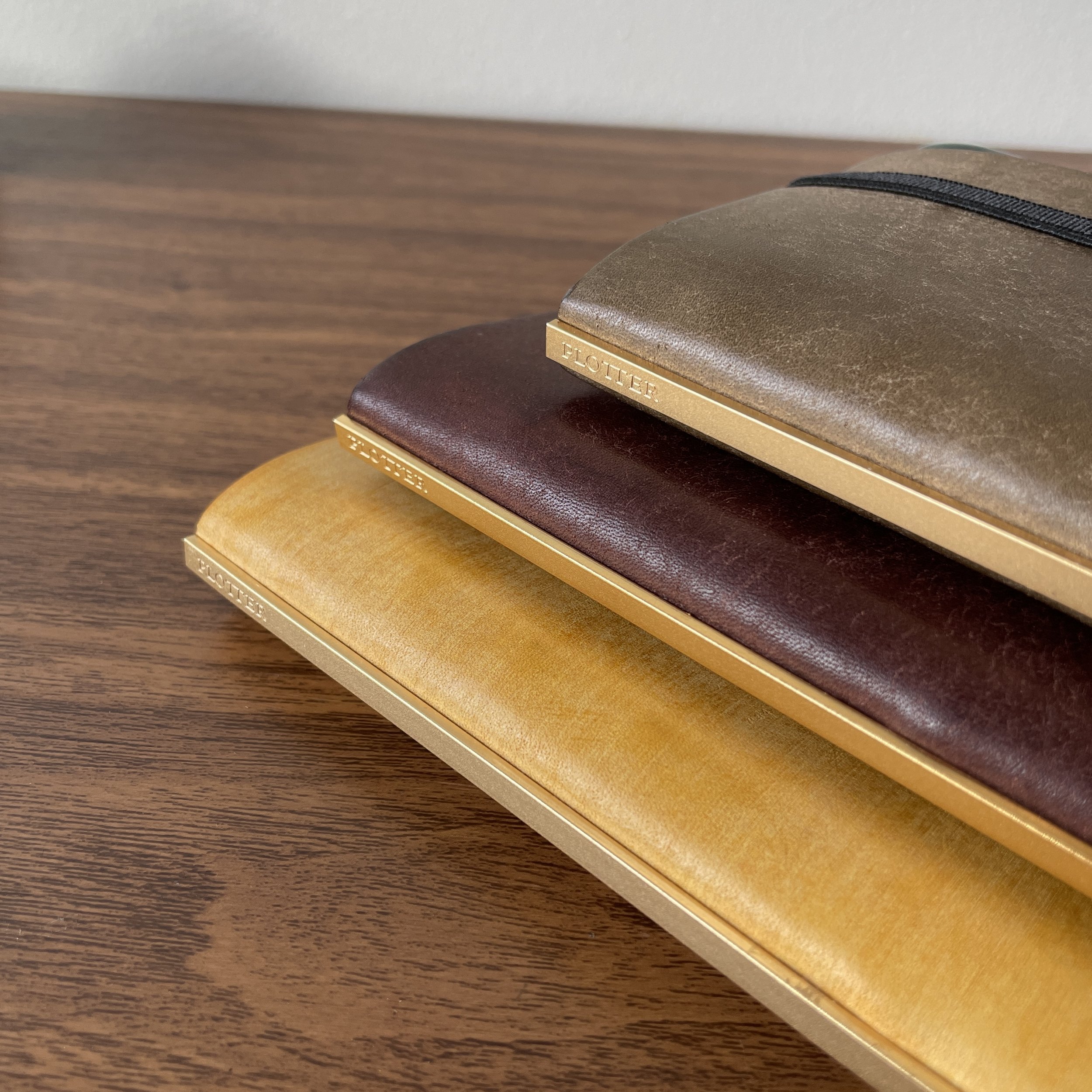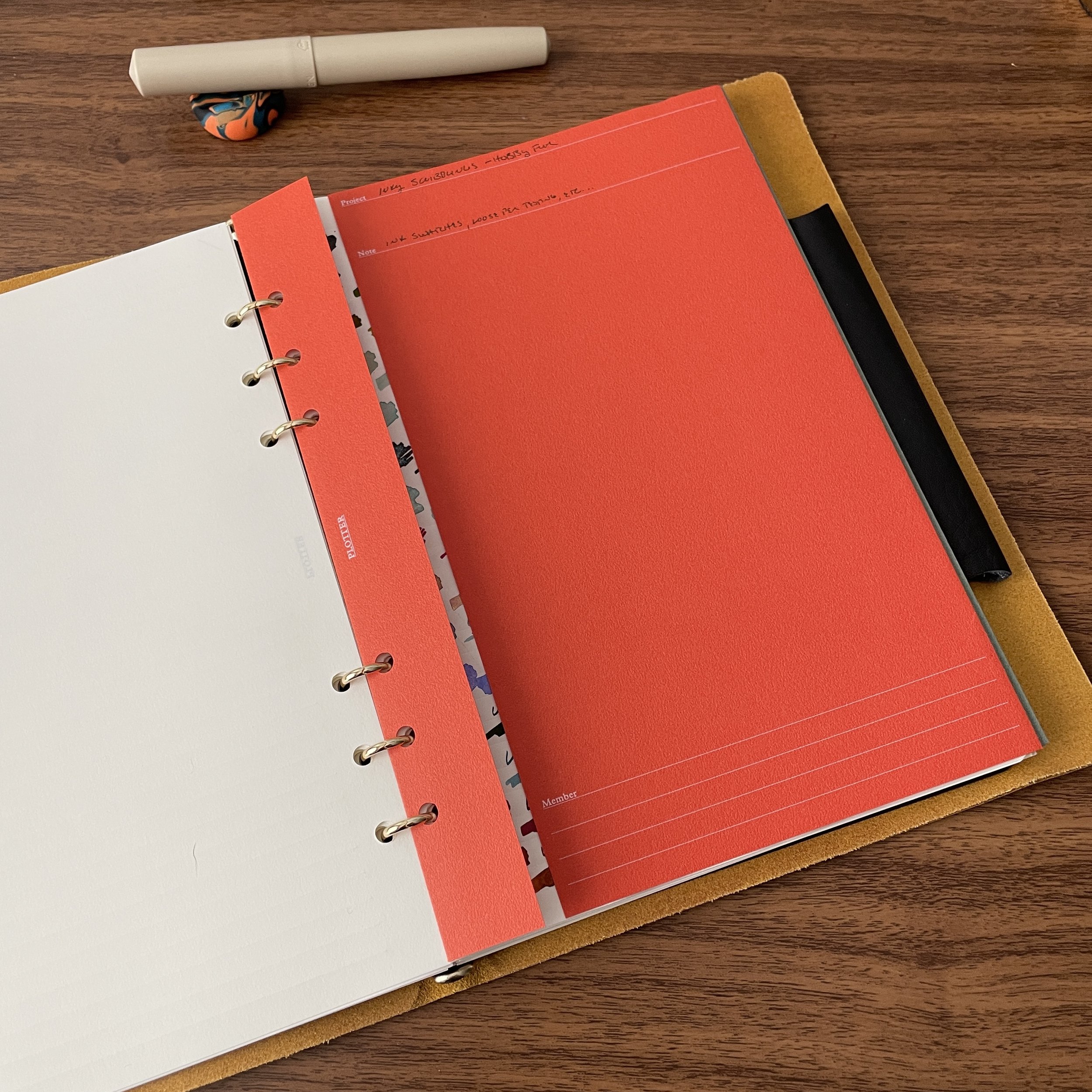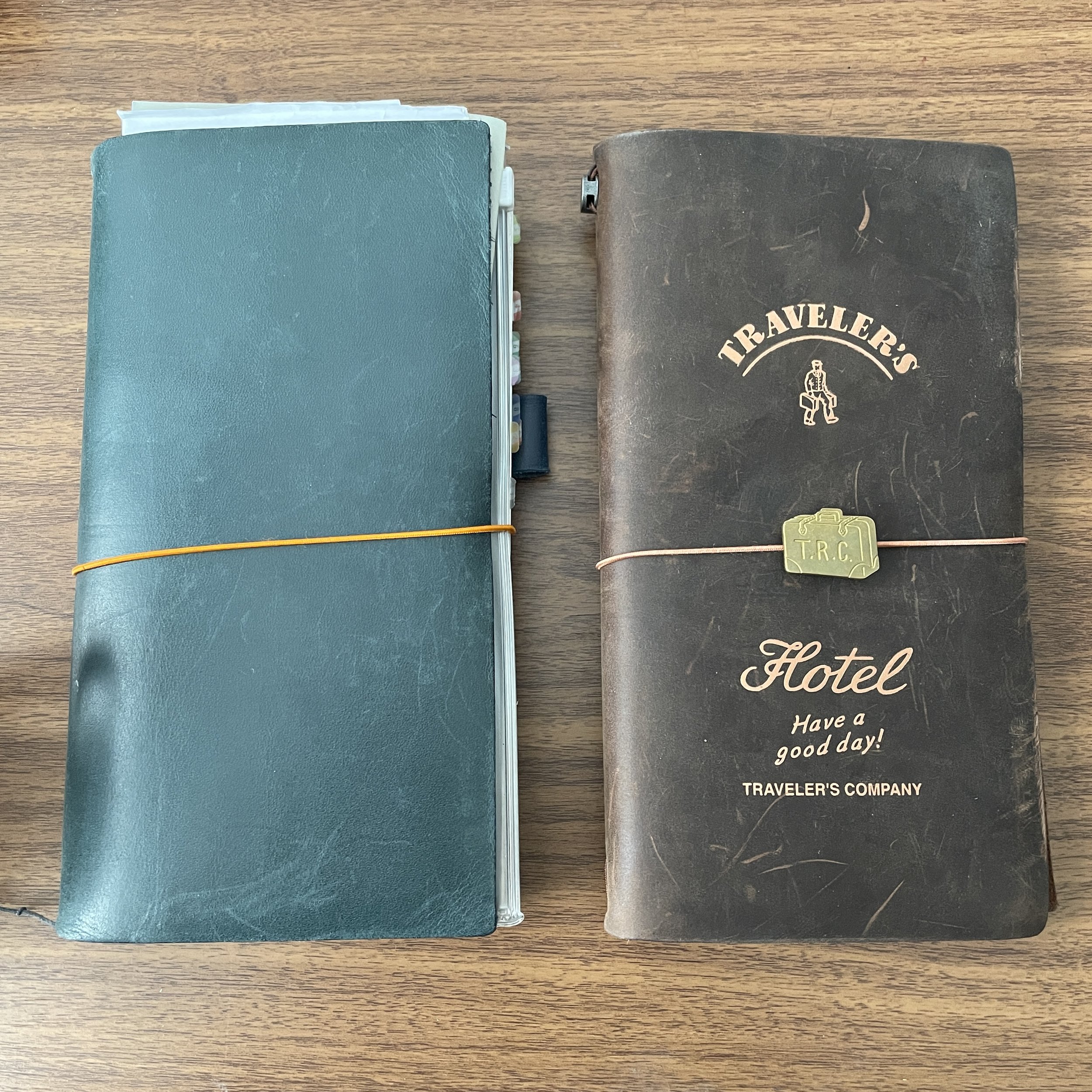The stationery community has many different sub-communities organized around specific interests, ranging from fountain pens to pencils to inks to paper. One common theme running through all the various groups, however, is an interest in notebooks, and more specifically Notebook Systems. Everyone seemingly has their own preference, but it’s easy to get lost in the different options available, especially with new brands and “systems” hitting the market every year. I hope my latest project, a multi-installment look at different Notebook Systems and how they can be used, will prove helpful.
Three Plotter leather binders, in different sizes. Plotter is a Japanese system recently introduced in the United States.
This first installment is definitional. As in, what are people referring to when they talk about “Notebook Systems” or “System Techo”? As far as I know, there’s no true “definition” of either term. Personally, I use “Notebook System” to broadly describe any line of notebook covers and compatible refills and accessories, typically (but not always) sold by a single company and designed to work in combination. “System Techo” is a term used mainly to refer to Japanese-style organizer systems, such as Plotter or Knox, which feature removable pages in a ring binder, or Hobonichi or Jibun Techo, which are bound dated diaries in a traditional book format. In this series of posts, I don’t intend to be overly rigid with how I characterize different brands and products. My goal is to more to familiarize you with the different systems and brands, group them together by what I consider to be common features, and give you some examples of how they can be used and how I personally use them.
The interior of a Plotter ring binder.
Binder Systems
Included in this category is really any notebook system that allows you to move individual pages around a notebook or binder, typically using either rings or discs with punched paper. While many people will recognize these as the “personal organizers” and calendar systems that were extremely prevalent here in the U.S. in the 1990s and early 2000s before the advent of smartphones, they remain extremely popular in Japan and are making a resurgence worldwide. The modern systems are much more versatile than a traditional planner. For professional reasons I won’t get into here, I don’t keep a paper calendar. Instead, I use my Plotters (the current preferred system) as more traditional notebooks that allow me to move around individual sheets and organize ideas I’m working on.
Examples of ring/disc-binder notebook systems include:
Plotter, which you’ll be reading more about in the future. Other brands include Filofax, perhaps the most popular brand of personal organizer in the world, Knox, and Rayman Davinci. (The latter two are Japan-only and as of the time of writing, do not have U.S. based retail options as-of the time of writing.)
Disc-bound Notebooks such as Levenger Circa, Staples Arc, and William Hannah.
Hobonichi Techo in A6, English version.
“Single Use” Bound Books
I place in this category the annual “diaries” such as the Hobonichi Techo series and those offered by other brands like Kokuyo and Midori. Originally intended to serve as dated planners, they’ve developed a devoted following around the world, and many people use them for journaling, habit-tracking or logging, or simply as dated notebooks. I’ve used the standard A6 Hobonichi Techo as a personal journal on-and-off over the years. I’ve also placed Stalogy and Midori MD in this category, since both have “day-to-a-page” or dated versions, as well as a range of accessories that allow users to set up undated notebooks as planners or otherwise customize them for specific needs.
Examples of these types of systems include:
My two Traveler’s Notebooks. The one on the left is years-old and well-used. The one on the right is one of this year’s 2022 Limited Editions.
Cover + Refill Systems
If systems such as Plotter and Filofax offer flexibility by allowing you to move around individual sheets of paper, others are built around smaller individual bound notebooks that can be swapped in and out of a specific cover or binder using cords and/or clips. I tend to use these types of systems for journaling (both personal and professional) and some drawing, and have long favored Traveler’s Notebooks due to their tall/narrow paper format. The Lochby Field Journal uses a similar cord-based binding for standard A5 refills, while Roterfaden relies on metal clips and comes in a variety of different sizes. Of the three systems discussed here, Traveler’s Notebook has the most active community, given that it’s the longest-tenured option with a robust line of accessories that includes folders, penholders, pouches, etc.
Examples of these types of systems include:
I use my notebooks on a daily basis.
Myths About Notebook Systems / System Techo
I use at least one example from each of the aforementioned categories on a near-daily basis. Part of why I wanted to do this series is to talk about how these notebooks aren’t just “collectibles” for me - I really do use them to manage my everyday work and personal life, and certain of them have proven invaluable as I find different systems appropriate for different types of writing. That said, I regularly get questions about “whether I actually use all these notebooks,” or other comments referencing one of many misconceptions about notebook systems and stationery in general. I’ll briefly address a few of them below.
Myth No. 1: Notebook Systems Are Extremely Expensive and Not Worth the Money.
First, anything is “expensive” if you pay money for it and never use it. Similarly, whether something is “worth the money” depends entirely on the value you personally derive from it. While there is an up-front investment required in some of the more intricate systems such as Plotter, Filofax, or Traveler’s Notebook, I use them so much on a daily basis that the $50-$250 I spent years/months ago to set up the system eventually fades into the background. That said, I would caution that it’s very easy to get carried away purchasing add-on accessories that you will never use. A solid strategy is to start with the standard binder and a few refills, and add to it as your needs evolve.
Myth No. 2: Notebook Systems Lock You into Proprietary Products.
Several years ago, that may have been the case. Today, however, nearly all of these systems offer a wide array of compatible refills in multiple papers and layouts. With respect to the ring and disc-based systems, purchasing a compatible hole-punch that allows you to use your own paper that you already have on hand can save you a lot of money over time while also increasing the flexibility of the system. I’ll plan to discuss this more when I talk about how I use Plotter and some of my Filofax notebooks. It’s also important to remember that if you’re willing to experiment, you can absolutely use accessories from one system with another. For example, I’ve cut down Stalogy notebooks to fit inside a Traveler’s Notebook cover, and regularly use the Midori MD system of tabs and sticky notes across brands.
Honestly, I use my various notebook systems for everything from day-job work to creative writing to managing my hobbies like ink-collecting :)
Myth No. 3: Notebook Systems Stifle Creativity.
This one I don’t really understand, but I think it’s derived from the belief that you shouldn’t buy nice/complex notebook systems because you start caring more about the system itself than the work that goes into it, paying more attention to the tool than putting words/art/work on paper. Honestly, I don’t feel like this is a valid reason not to buy notebook because that logic can be applied to anything: pens, computers, phones, or any other object. If you buy it as a tool, use it as such. Don’t worry about getting it dirty or maintaining it in pristine condition or setting up the “perfect” workflow - through regular use the object itself eventually disappears and just becomes part of your everyday.
Myth No. 4: In the Age of Phones, “Planners” Are Obsolete.
In certain occupations where managing deadlines and seamlessly coordinating multiple schedules is essential, it’s extremely difficult, if not impossible, to use a paper planner as your primary calendar. That said, while setting alerts and electronic notifications on your phone is an excellent failsafe, I’ve found that it helps me to track, manage, and prioritize tasks if I maintain a handwritten list that I revisit daily. And, as I’ll discuss further in this series, nearly all of these “systems” are much more than calendars or planners, and it’s unwise to simply write them off as such.
Always invest in the pen loop.
What to Expect from This Series Going Forward
I don’t have a clear idea how many different installments this particular series of articles will entail. At a minimum, I want to discuss each of the three rough categories of Notebook Systems discussed above, what I like/dislike about each one, and how I use them. That said, I can envision those articles getting very long, so I might break a couple of them into multiple articles where I discuss specific brands individually. Stay tuned!
The Gentleman Stationer is supported entirely by purchases from the T.G.S. Curated Shop and pledges via the T.G.S. Patreon Program. The Gentleman Stationer does sell certain of the products discussed in this article, though this post does not contain any paid third-party sponsorships or affiliate links.



